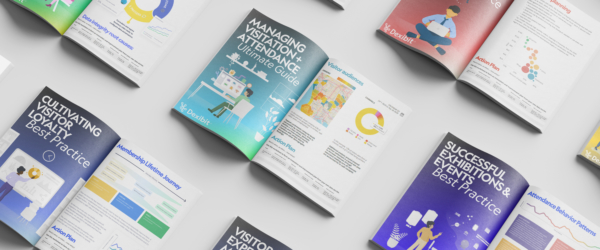Leading data at scale
- In Blog, Multiple locations
- enterprise, government, Multiple locations
- 3 min read
Over the past year, we’ve implemented Dexibit across a number of large enterprise and government customers of significant scale – each across a volume of locations.
Leading data programs across distributed teams presents many opportunities and challenges over and above those of individual venues.
Here’s the highlights we’ve incorporated into our approach:
1. Start fast: data beats slideware
Even if it’s a quick proof of concept or a pilot limited to a few locations, getting started in real data provides unparalleled traction for large organizations. More than any data audit or research report, it will pull up logistical issues with a data vision, uncover unexpected depth in insights and shake out practical use cases in an organic way. This speed delivers value to the organization and its users immediately and sets the pace for adoption rather than spending months or even years trapped in data strategies and audits without progress on the ground. Expect change to take time. It’s especially true when needing to influence users in different on location teams, each on their own data journey. Have head office set an example and keep at it – data is something you encourage people to and educate on, rather than just roll out.
2. Multiple locations need multi tenancy
When implementing analytics in multiple locations it’s important to have multi tenancy to support a parent/child structure between head office and individual locations for data and users. Sometimes this might be in multiple levels, for example to support locations that are divided into brands, regions or other management portfolio structures. Where the number of locations exceeds 10 or so, the portfolio also needs cohorts to cut across tenants in different combinations to display data effectively (such as ‘family entertainment’ and ‘west coast’ etc).
Multi tenancy means some users can see or have control over all locations, others might see only one, or a subset. It also means when these users publish data assets such as dashboards to share with others, this act is only with their immediate team, rather than crowding the shared space for all users everywhere. This structure allows data automation to account for data piped in at a head office, sub account or location specific level, depending on how broad or specific source systems are. For example, while some systems such as ticketing may be common to all, others such as a Google Business review site will be site specific.
For users on location, it’s also important to allow for localization such as the time zone, data format, currency, metric etc. Some settings will be required against the location, some against the user’s profile.
Dexibit’s identity management and data automation platforms are designed exactly with this in mind, providing for multi tenant, multi level management with automatic localization.
3. Orchestrating to combine, contrast and compare
The flow of data from locations to head office across various metrics and systems is often manual, prone to delays, gaps and inconsistencies. Automating this into a real time view shared between location and head office teams is a significant win for collaboration and eases the burden of management and reporting for either side.
At the head office level, data consumers then need the ability to combine, contrast and compare at a dashboard or report and visualization level – creating views across the portfolio, deep diving within a location, or slicing and dicing a view or visualization across select locations.
Democratizing data at this scale is a joy for users to quickly jump between locations and sources to track performance, discover insight and create data stories.
4. Standardize but allow for variance
Where possible, once data is coming in, it’s worthwhile to standardize how metrics such as visitation, revenue and membership are recognized and document these into an operating procedure for each location. This breaks down locations feeling that their data is too unique to be compared to others, or a sense of unfairness in performance contrasts. However, don’t be overly strict in these recognition practices. It’s likely among multiple locations that there will be variances to business or operating models – some might charge admission and others not, some have event based visitation and others regular, some involve third parties and others do everything in house, so provide a flexible approach.
Dexibit’s data automation platform allows each location to specify their recognition rules within a common data model and framework, alongside clear documentation for knowledge management.
5. Machine learning and natural language deliver impressive returns at scale
We recommend quickly reaching for machine learning for forecasting visitation, revenue and more, plus natural language to manage the voice of the visitor at scale by interpreting freeform visitor comments into quantitative sentiment and topics. Both automate otherwise highly manual jobs, or provide data into previous voids.
Though the technology lift for these is heavy, with Dexibit’s industry best practice data model and existing unique models researched and trained sector wide, predicting and analyzing visitor behavior with artificial intelligence can be a surprising quick win at scale. The gains for efficiency, planning and insight are significant. Expect stakeholders to need time in developing trust and confidence in using artificial intelligence in their decisions and operations.
6. Establish internal benchmarks within external context
Groups with 5+ locations benefit from establishing their own benchmarks on key metrics such as visitation and revenue recovery and growth as well as others such as visitor happiness. It’s also possible to work in group benchmarks to deeper insights, such as a distance traveled, or even sentiment on a common theme such as pricing. Benchmarks should track change over time, rather than just a snapshot. However, it’s also important to contextualize group and individual location results within an industry benchmark to avoid becoming too internally focused.
In Dexibit, you can create group wide or cohort based benchmarks, comparing back to global benchmarks and local cohorts for each of your locations.
7. Over time, analyze visitor behavior across and between locations
Many attraction groups of scale are in the process of centralizing CRM strategies and developing loyalty programs which allow them to track visitors across different locations. Data from these systems can power fascinating insights into visitor journeys: to what degree the visitor’s experience with the parent brand is singular; how much audiences overlap and present a cross marketing opportunity; how many locations a visitor visits, how often and how patterned – particularly so for attractions with many locations within a region. However, the visitor experience and the systems and procedural change behind these insights are immense – this should be a vision and roadmap item, not a first objective.
8. Have a strong communications plan
Perhaps the most defining factor of a data program at scale is the level of communications from initiative leaders. Make sure executives provide the aspirational ‘why’ of the work, celebrate quick wins, showcase achievements, keep the team focused on delivering value to the end data consumer and continue to lead by example on being data informed and insight inspired. Adapt messaging to whether your users are willing and/or able to adopt data – in understanding it and acting upon it.
9. Create an internal data community
Beyond pure communication, one way to supercharge the data culture within an attraction group is to establish an internal data community – not one just for experts, but a place of psychological safety for champions and newbies alike to learn from each other about how to use data. This can also help overcome the reality that in an attraction group of scale, analysis skill sets are both centralized and distributed, sometimes across multiple departments.
10. Big doesn’t mean build
It’s easy to fall into the build trap. Total cost of ownership is still better on the side of buying a product versus building in house – even at significant scale. This is especially so when factoring in the special requirements of multiple location portfolios, such as those stemming from multi tenancy. The biggest cost of all in building an inhouse solution is time sunk with unknown risk, in the magnitude of millions of dollars and several years, triggering a never ending cycle of maintenance, change requests and playing catch up. A productized solution like Dexibit means a proven solution, instant unlock and continued innovation allowing in house data leaders to focus on influencing change and advancing their data vision.
Get insights delivered right to your inbox
Want to learn more about Dexibit?
Talk to one of our expert team about your vision to discover your data strategy and see Dexibit in action.



